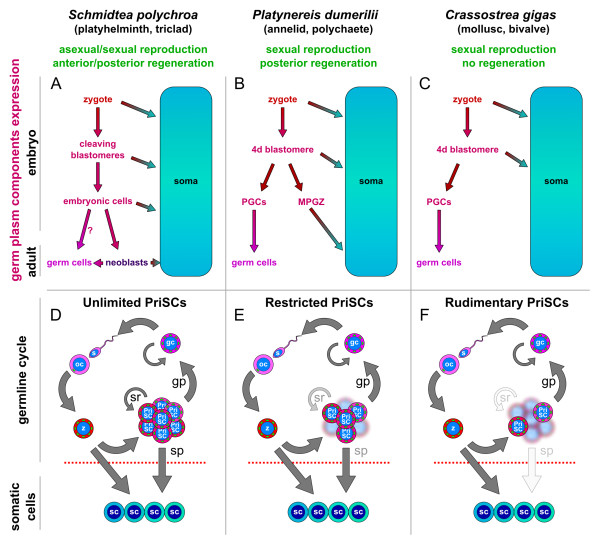Figure 3.
Germ plasm components expression in lophotrochozoans and their germline cycles. (A-C) Schematic of Schmidtea polychroa (A), Platynereis dumerilii (B) and Crassostrea gigas (C). (A) The cleaving blastomeres of S. polychroa express germ plasm components and likely give rise to the embryonic cells. These cells are believed to give rise to the neoblasts, but also to GCs and somatic tissues. (B) A putative germ plasm is found in the zygote of P. dumerilii and inherited by the 4d blastomere, which generates the PGCs but also the MPGZ, a germ plasm component-containing proliferative tissue with somatic potential (C) The early embryonic development of C. gigas is similar to that of P. dumerilii. However, only 2 cells derived from the 4d blastomere still show germ plasm components: they are believed to be the PGCs and become quiescent until later stages. (D-F) Modes of germline cycle in S. polychroa (D), P. dumerilii (E) and C. gigas (F). (D) Unlimited PriSCs: the zygote in S. polychroa gives rise to a population of stem cells (the PriSCs) with self-renewal (sr) and both somatic (sp) and germ potential (gp). (E) Restricted PriSCs: In P. dumerilii the 4d lineage is a population of pluripotent stem cells with both somatic (sp) and germ potential (gp) with more restricted self-renewal. (F) Rudimentary PriSCs: The germ plasm-containing cells of C. gigas only retain dual germ/soma potential for a few divisions and only the PGCs retain germ plasm components. Dotted red lines depict the proposed germ-to-soma boundary. GCs, germ cells; MPGZ, mesodermal posterior growth zone; PGCs, primordial germ cells; PriSCs, primordial stem cells.

